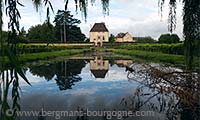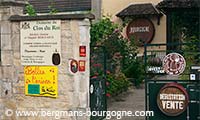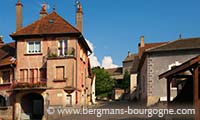
hat many do not realise is how small the Côte d'Or is. The département of Côte d'Or is fairly big, but the strip of land that has made Burgundy world famous for its wines is only a small part of that. It runs from the outskirts of Dijon down to Santenay and Maranges; 50 kilometres interrupted by a number of small villages. At the most it is a couple of kilometres wide; in some cases only a few hundred metres.
The Côte d'Or is divided in two parts – the Côte de Nuits and the Côte de Beaune. The former is centered around Nuits-Saint-Georges and stretches from Marsannay in the north down to the border between Corgoloin and Ladoix-Serrigny. The latter is south of the Côte de Nuits, with Beaune as its centre, going all the way down to the three Maranges – Cheilly-lès-Maranges, Dezize-lès-Maranges and Sampigny-lès-Maranges.

Côte de Nuits is the northern half of the Côte d'Or, stretching from the outskirts of Dijon down to the border between Corgoloin and Ladoix-Serrigny. This is where you find the majority of the grand crus of Burgundy. Out of a total number of 32 grand crus 24 can be found here. Driving from Dijon down to Nuits-Saint-Georges, which is the commercial centre of the Côte de Nuits, you pass many small villages with world-wide fame; Gevrey-Chambertin with its Chambertin and Chambertin Clos de Bèze, Musigny with its Bonnes-Mares and Musigny, Vosne-Romanée with its La Tâche and its Romanée-Conti and Vougeot with its Clos de Vougeot. With a few exceptions the wines are red. Only seven percent of the production is white.
South of Nuits-Saint-Georges the vineyards are interrupted by a series of limestone quarries. In Corgloin the vineyards continue, and as you leave the Côte de Nuits you see the mighty Corton hill in front of you.

Côte de Beaune includes all the communes from Ladoix-Serrigny in the north to the trio of Dezize-lès-Maranges, Sampigny-lès-Maranges and Cheilly-lès-Maranges in the south. As the name suggests it is the town of Beaune with its 21800 inhabitants that is the centre of this part of the Côte d'Or. Beaune is also the wine centre for the Côte d'Or and it is here that you find many of the big négociants such as Drouhin, Jadot and Bouchard.
While the villages of the Côte de Nuits are nicely lined up from north to south, the ones on the Côte de Beaune are spread out on a broader area. Some are tucked away up in valleys, others down on the plain.
This is often regarded as white wine country. The white grand crus are here and you have villages such as Meursault, Puligny-Montrachet and Chassagne-Montrachet that are primarily known for their whites. Still, the white wines only accounts for 40 percent of the production on the Côte de Beaune.
© 2013 Ola Bergman













